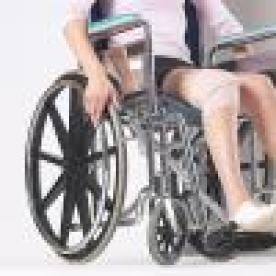Every pedestrian accident is dangerous and most result in serious injuries or the death of the pedestrian where the motorist in the vehicle escapes unharmed. National statistics reveal that every year approximately 5000 individuals lose their lives in pedestrian accidents and more than 75,000 suffer serious injuries.
A new study revealed that wheelchair pedestrians are at greater risk for suffering catastrophic injuries or losing their life if involved in an accident with a motor vehicle. Most catastrophic wheelchair pedestrian/vehicle accidents occur in crosswalks or along stretches of roadways where no crosswalk is available. The study also revealed the remarkable fact that in nearly four out of every five vehicle accidents involving wheelchair pedestrians, the motorist took no action to avoid the collision.
Many believe there are numerous factors involved in the disproportionate potential risk for wheelchair pedestrians compared to others traveling on foot and crossing roadways. One factor may be that it is often more difficult to notice an individual in a wheelchair because they are lower to the roadway or sidewalk. Another factor might be that when a crash occurs, the torso and head of the wheelchair user is more likely to be struck directly compared to a walking pedestrian being struck in the thighs and pelvis area. Finally, the increased risk of injury of a wheelchair user might be the result of their already compromised health making it more challenging to recover from serious trauma.
More Conscientious Driving
The above statistics make it all too obvious that motorists must drive more conscientiously and diligently when behind the wheel. If the driver is more aware of their surroundings they are more likely to brake, swerve or take some evasive action in time to avoid a collision with a pedestrian. Failing to provide a wheelchair user the right-of-way could mean the difference between their life and death.
Unfortunately, drivers today face more distractions than ever before. In addition to listening to the radio, eating or consuming beverages while driving, motorists are now distracted by GPS systems, speaking on their cell phones, texting and even reading emails when operating their vehicle. Other inappropriate conduct includes failing to obey the rules of the road, speeding, rushing to beat the red light, driving while impaired and fatigue.
Any distraction that averts the driver’s eyes from the roadway has the potential of causing a serious accident with pedestrians, bicycles, and others sharing the road. Failing to notice a dangerous condition for even a split second might not provide adequate time or distance to react appropriately to avoid a collision with someone on the road.
Pedestrian Accident Contributing Factors
According to the National Highway Traffic Safety Administration (NHTSA), there are numerous contributing factors that tend to be common in most wheelchair related collisions. These include:
-
The driver’s failure to predict the actions or movement of the disabled pedestrian in a wheelchair
-
The driver’s failure to even notice the wheelchair bound individual legally crossing the roadway
-
A lack of available crosswalks in urban and rural environments to provide a safe to market area for the wheelchair-bound traveler to safely use the road
The data from the National Highway Traffic Safety Administration (NHTSA) revealed that there is no substantial difference or changing contributing factors between manual and electric wheelchairs.
Making Improvements to Pedestrian Safety
In 1990, the U.S. Congress passed the Americans with Disabilities Act (ADA), which is a comprehensive civil rights law and a first major step that addresses the needs of individuals suffering with disabilities. The act was designed to prohibit discrimination of disabled individuals involving public accommodations, public services, telecommunications and employment.
Part of that law was designed as a way to improve road safety for disabled individuals. This involved making roads, sidewalks, curbs and crosswalks more accessible to the disabled including those in wheelchairs. Unfortunate, many communities still lack the proper pedestrian infrastructure. This is usually the result of urban planners and traffic engineers not focusing enough attention when developing and redesigning areas in the community to enhance roadway accessibility to the disabled and others at greater risk of suffering serious harm or death.
In many parts of the country, commuters and pedestrians still face dangerous conditions that include poorly lit intersections and a lack of traffic controls (stop signs and stoplights). In addition, high-speed traffic areas can also be extremely hazardous to every pedestrian including the blind, deaf and those who are wheelchair-bound. The only sure way to minimize the risk of harm or death to pedestrians is to take appropriate measures and provide adequate and proven effective traffic controls and ensure that intersections and crosswalks are well lit at night.




 i
i


